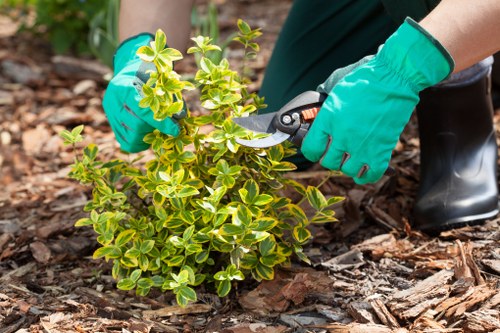Lawn Mowing in Garden Services: Achieving a Pristine Yard
Introduction to Lawn Mowing

Lawn mowing is a fundamental aspect of garden maintenance that not only enhances the aesthetic appeal of your property but also promotes the health and vitality of your grass. Regular mowing helps in controlling weed growth, maintaining even grass height, and preventing pest infestations.
Incorporating lawn mowing into your garden services ensures that your outdoor space remains well-kept and inviting. Whether you manage your lawn yourself or hire professionals, understanding the essentials of mowing can lead to a lush and vibrant yard.
Proper lawn mowing techniques can make a significant difference in the overall appearance and health of your garden. This article explores the key aspects of lawn mowing within garden services, offering insights and tips for achieving the best results.
The Importance of Regular Lawn Mowing

Regular lawn mowing is crucial for several reasons:
- Health of the Grass: Mowing stimulates grass growth by encouraging the blades to thicken and become more resilient.
- Weed Control: Consistent mowing prevents weeds from seeding and spreading throughout your lawn.
- Enhanced Curb Appeal: A well-mowed lawn significantly boosts the visual appeal of your property.
- Prevention of Pests: Shorter grass reduces hiding spots for pests, minimizing the risk of infestations.
Understanding these benefits highlights why lawn mowing is an integral part of garden services. Regular maintenance not only keeps your lawn looking its best but also contributes to a healthier and more sustainable outdoor environment.
Choosing the Right Mowing Equipment

Selecting the appropriate lawn mowing equipment is essential for achieving optimal results. The choice of mower depends on several factors, including the size of your lawn, terrain, and the type of grass you have.
Types of Lawn Mowers
- **Push Mowers:** Ideal for small to medium-sized lawns, push mowers are eco-friendly and cost-effective.
- **Self-Propelled Mowers:** Suitable for larger lawns, these mowers reduce the effort required to push them.
- **Riding Mowers:** Best for extensive properties, riding mowers offer comfort and efficiency for large-scale lawn maintenance.
- **Electric Mowers:** Environmentally friendly options that are quieter and require less maintenance compared to gas-powered models.
Investing in the right equipment ensures that your lawn mowing activities are efficient, effective, and tailored to your specific garden needs.
Best Practices for Lawn Mowing

Adhering to best practices when mowing your lawn can significantly improve its health and appearance. Here are some essential tips to consider:
Mowing Frequency and Height
- Frequency: Generally, mowing once a week during the growing season is recommended. However, this can vary based on grass type and growth rate.
- Height: Maintaining the correct mowing height is crucial. Cutting grass too short can stress the plants, while leaving it too long may encourage weeds.
Typically, a mowing height of 2.5 to 3 inches is ideal for most grass types. Adjusting the mower to the appropriate height ensures that the grass remains healthy and resilient against environmental stresses.
Proper Mowing Techniques
Using the correct techniques can enhance the effectiveness of your mowing sessions:
- **Mow When Dry:** Wet grass can clump and lead to uneven cutting. Mowing when the grass is dry results in cleaner cuts.
- **Alternate Mowing Patterns: Changing your mowing direction each session prevents grass from developing a grain and encourages even growth.
- **Sharpen Mower Blades: Sharp blades ensure clean cuts, reducing the risk of disease and promoting faster healing of the grass blades.
- **Leave the Clippings:** Mulching clippings can return valuable nutrients to the soil, enhancing lawn fertility.
Seasonal Lawn Mowing Tips

Each season presents unique challenges and requirements for lawn mowing. Adjusting your practices accordingly can lead to a thriving lawn year-round.
Spring
As the grass begins to grow, increase mowing frequency to promote dense growth. Remove any debris and prepare your lawn for the active growing season.
Summer
During hot months, maintain a higher mowing height to provide shade to the roots and retain soil moisture. Watering your lawn deeply encourages deep root growth.
Fall
Gradually reduce mowing frequency as growth slows. Rake fallen leaves to prevent them from suffocating the grass.
Winter
Minimal mowing is required during the dormant season. Prepare your equipment for storage and plan for the upcoming growing season.
Adapting your lawn mowing routine to the seasons ensures that your grass remains healthy and well-maintained throughout the year.
Environmental Benefits of Proper Lawn Mowing
Effective lawn mowing practices contribute to various environmental benefits, making it an eco-friendly component of garden services.
Carbon Sequestration
Healthy lawns act as carbon sinks, absorbing carbon dioxide from the atmosphere and helping to mitigate climate change.
Water Conservation
Proper mowing techniques, such as maintaining an optimal grass height, reduce water evaporation and promote efficient water usage.
Biodiversity
A well-mowed lawn supports biodiversity by providing habitats for beneficial insects and other small wildlife, contributing to a balanced ecosystem.
- Pollinator Support: Certain grass cuts can create microhabitats for pollinators like bees and butterflies.
- Soil Health: Regular mowing helps maintain soil structure and prevents erosion.
Reduction of Chemical Use
By promoting healthy grass growth through proper mowing, the need for chemical fertilizers and pesticides decreases, resulting in a safer and more sustainable garden environment.
Choosing Professional Lawn Mowing Services
While DIY lawn mowing can be rewarding, hiring professional garden services offers numerous advantages:
Expertise and Experience
Professional lawn care providers possess the knowledge and skills to handle various grass types and lawn conditions, ensuring optimal results.
Time and Convenience
Outsourcing lawn mowing frees up your time, allowing you to focus on other priorities while ensuring that your lawn receives regular care.
Advanced Equipment
Professionals utilize high-quality, specialized equipment that delivers precise and efficient mowing, often achieving results that surpass those of standard residential mowers.
Comprehensive Services
Many garden services offer a range of additional lawn care options, including fertilization, aeration, and pest control, providing a holistic approach to lawn maintenance.
Cost-Effectiveness
While there is an upfront cost, the long-term benefits of professional lawn mowing, such as increased lawn longevity and reduced need for repairs, can make it a worthwhile investment.
Choosing professional garden services for lawn mowing ensures that your lawn is maintained to the highest standards, promoting both beauty and health.
Maintaining Your Lawn Between Mowing Sessions
Beyond regular mowing, maintaining your lawn involves several practices that contribute to its overall well-being.
Watering Practices
Proper watering is essential for a healthy lawn. Deep, infrequent watering encourages deep root growth, making the grass more drought-resistant.
Fertilization
Applying the right fertilizers at appropriate times supports nutrient uptake, promoting lush and green grass.
Weed Management
Regularly removing weeds manually or using eco-friendly weed control methods helps maintain grass dominance and prevents unwanted plants from taking over.
Aeration
Aerating your lawn allows air, water, and nutrients to penetrate the soil more effectively, supporting robust grass growth.
Overseeding
Overseeding fills in bare spots and improves lawn density, enhancing its appearance and resilience against environmental stressors.
Implementing these maintenance practices in conjunction with regular mowing creates a harmonious and thriving lawn.
Common Lawn Mowing Mistakes to Avoid
Avoiding common mistakes can prevent damage to your lawn and ensure that mowing contributes positively to your garden's health.
Cutting Too Short
Cutting grass too short, also known as scalping, weakens the grass by exposing the soil to harsh conditions and increasing susceptibility to weeds and pests.
Inconsistent Mowing Height
Varying the mowing height excessively can stress the grass and lead to an uneven appearance. Maintain a consistent height to support uniform growth.
Neglecting Blade Maintenance
Dull mower blades tear the grass instead of cutting it cleanly, which can lead to disease and hinder growth. Regularly sharpen or replace blades as needed.
Mowing at the Wrong Time
Mowing during peak sunlight hours can cause heat stress on the grass. Opt for cooler parts of the day, such as early morning or late afternoon, to minimize damage.
Skipping Mowing Sessions
Allowing grass to grow too long between mowings can lead to overgrowth, making the next mowing session more stressful for the lawn. Maintain a regular mowing schedule to promote healthy growth.
Being aware of and avoiding these common mistakes can lead to a healthier, more attractive lawn.
Innovations in Lawn Mowing Technology
The lawn mowing industry has seen significant technological advancements that enhance efficiency, precision, and sustainability.
Robotic Mowers
Robotic mowers offer automated lawn maintenance, allowing for consistent mowing schedules without manual intervention. These devices are programmable and can navigate complex lawn layouts with ease.
Battery-Powered Mowers
Battery-powered mowers provide a quieter and more environmentally friendly alternative to traditional gas-powered models. They require less maintenance and reduce emissions.
Smart Mowing Systems
Integrating smart technology, these systems can be controlled remotely via smartphones or voice commands. They often include features such as scheduling, obstacle detection, and performance monitoring.
Eco-Friendly Mowing Practices
Advancements in sustainable mowing practices, such as solar-powered mowers and energy-efficient designs, contribute to reducing the environmental impact of lawn maintenance.
Precision Mowing Techniques
Innovative mowing techniques and equipment ensure precise cuts, reducing waste and enhancing the overall appearance of the lawn.
Embracing these technological innovations can lead to more effective and sustainable lawn mowing practices, benefiting both homeowners and the environment.
Conclusion

Lawn mowing is a vital component of garden services that goes beyond mere aesthetics. It plays a critical role in maintaining the health, sustainability, and beauty of your lawn.
By understanding the importance of regular mowing, choosing the right equipment, adhering to best practices, and avoiding common mistakes, you can achieve a pristine and vibrant yard. Additionally, leveraging professional services and embracing technological advancements can further enhance your lawn care routine.
Investing time and effort into proper lawn mowing not only elevates the look of your garden but also contributes to a healthier and more enjoyable outdoor space for you and your family.
Contact us today to book your lawn mowing service and take the first step toward a beautifully maintained garden.